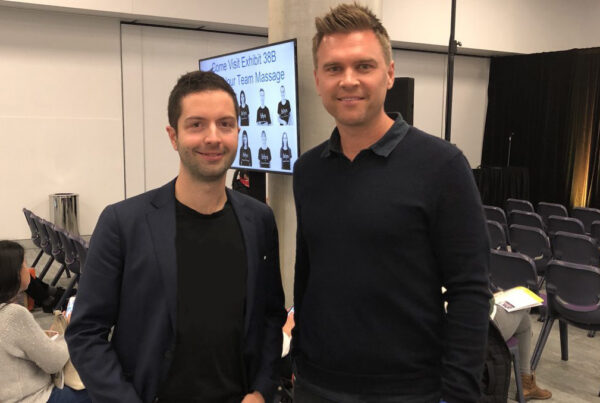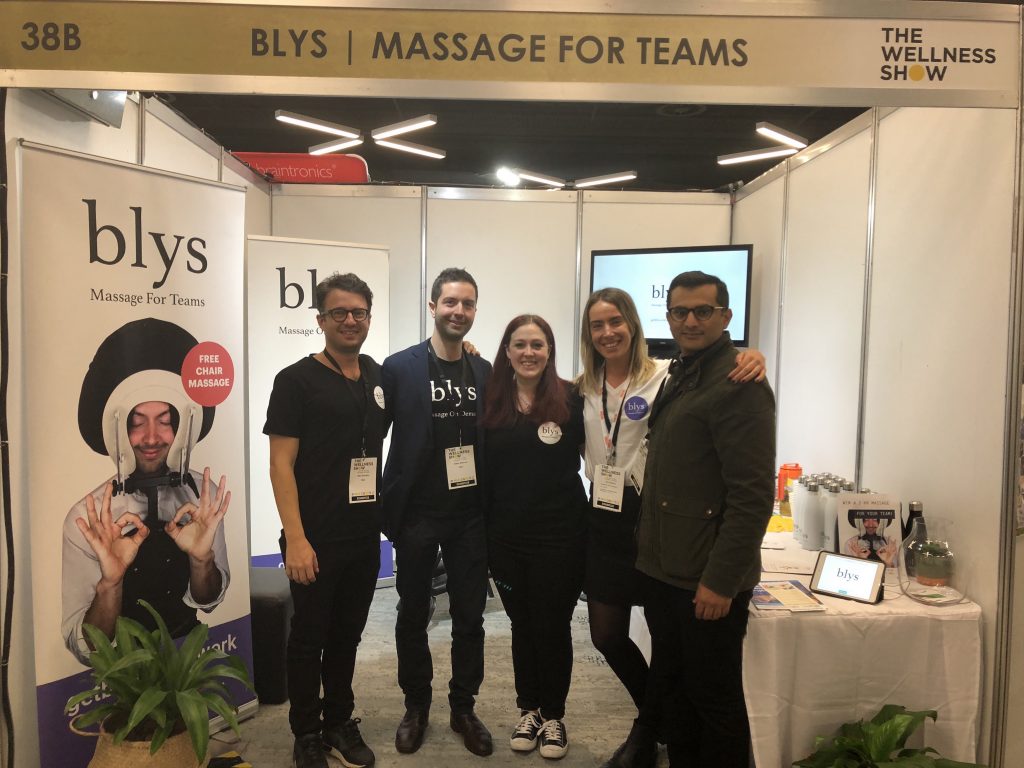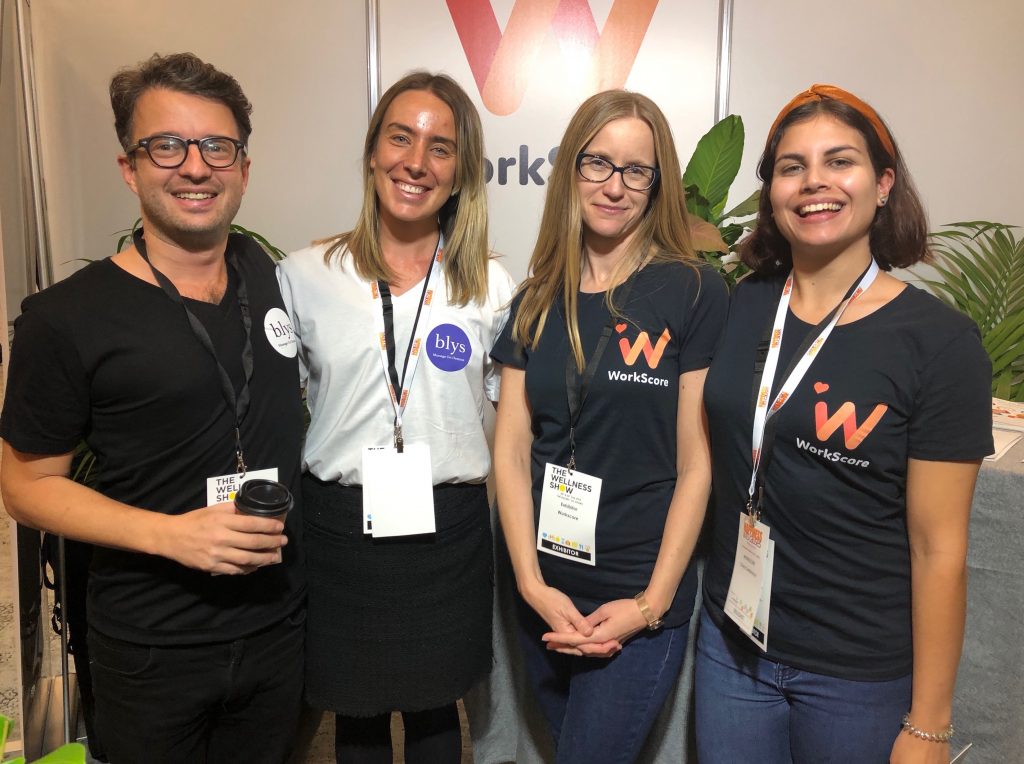The Wellness Show and Happiness and its Causes is a combination that would make almost any health and wellness nut burst with excitement. Why? In just two days you have the opportunity to listen to the Dalai Lama share his thoughts on compassion and happiness, and learn from experts in the health, business and psychology field about everything from maximising team productivity to cultivating a growth mindset. In between talks you get to sip on delicious tea and snacks, relax with free massages, and discover innovative products and services that are revolutionising the health and wellness industry in Australia. The Blys team were lucky enough to experience this firsthand. These are some of the highlights.
Fireside chat with Nick Ingall from Safety Culture

We kicked off the conference with a fireside chat between Safety Culture’s Head of People and Culture, Nick Ingall, and our Head of Corporate Partnerships, Allan Manuel. Safety Culture is an Australian founded technology start-up that builds software in the safety and quality space. Their mission is to help workers go home safe, every single day. Although safety and quality isn’t necessary a “sexy” industry, it’s an extremely important one says Ingall. Recent statistics indicate that every 15 seconds someone dies from a workplace incident or illness somewhere around the world. Safety Culture is on a mission to change this!
Some of the highlights, as well as the transcript, of the seminar & our chat with Nick below.
1) Fireside Chat with Nick Ingall – Head of People Culture – Safety/Culture
https://youtube.com/watch?v=l2RAvZbg_K4%22
Read the full script here
2) Blys Seminar – How To Build High Performing Teams with Allan Manuel
https://youtube.com/watch?v=d4UiuVmU7vE%22
3) The Dalai Lama live from his home in Dharamsala, India
The packed auditorium of 2000 plus people waited in anticipation as the connection was made with the Dalai Lama in India. In between bellowing laughter, the Dalai Lama chatted about everything from compassion, dealing with negative emotions, the history of country and even his view of Donald Trump. In case you missed it, you can listen to similar discussions on the official Dalai Lama website.
4) Insights from leaders in mindset and psychology
Happiness and its Causes is known for its lineup of leading psychology and health experts from around the globe. This year’s lineup included innovative (and hilarious) experimental psychologist Richard Wiseman, pioneering researcher into self-compassion Dr. Kristen Neff, and one of the most influential psychologists in self-control and self-esteem, Professor Roy Baumeister.
5) Massage and meet-ups at The Wellness Show
Over the two days at The Wellness Show, we met with delegates, health exhibitors and even some Blys therapists in and around the pop-up booth. The free chair massages were by far the highlight of the pop-up and got snapped up in an instant! Thanks to Savanna Rose for working your massage magic over the two days!
 6) The Blys team at the massage pop-up
6) The Blys team at the massage pop-up
 7) The Blys team with WorkScore
7) The Blys team with WorkScore
Fireside Chat with Nick Ingall Script
Allan: How do you instill recognition and meaning in your team to get them all really well aligned?
Nick: The meaning is a good one. Traditionally we operate in the blue collar industry. These individuals are not tech savvy. Everyone has a smart phone today that they keep in their back pocket and so the whole meaning, the whole culture around safety and quality is changing and shifting because we are giving workers out there the capability of actually changing the current process.
Safety and quality is not cool, it’s not sexy. However through innovative technology we are refroming how people think about safety and quality which is really important. So for us, internally, recognising that is one of the biggest things and biggest things and biggest reasons why people come to work at safety culture today.
Internally at safety culture we have two different platforms that we use for recognition. One is called Lattice. Lattice is something you use for more significant feedback. So in two or three paragraphs you can say to someone – Great job, I saw you hit your monthly goals – keep it up!
The second tool we use is called Slack. Slack is our instant communication tool. This is for the off-the-cuff recognition. These are the two tools that we are taking for recognition.
Allan: How do you keep the great culture as you start to scale and ramp up the organisation?
Nick: In the early days people joined because they really buy into the mission of safety culture. As I said before, to most people its not cool and not sexy but we’re solving a really important problem. We’ve now raised $90M in venture capital. The VC is here in Australia and also in the United States and United Kingdom. It’s a lot of money and now the brand is starting to get out there in the market.
The biggest thing we need to focus on as we scale is culture. The pinnacle as to why we come to work every day. The biggest investment we have made is into our onboarding bootcamp. There’s about 15-20 people that start at safety culture every month. Usually four or five of these are coming from our US and UK office so we are flying them out to Sydney for a week. We’re covering their flights, accom and stuff in between. A HUGE investment for a start-up business.
We’ve gone from 75 to 220 employees in about the last 15-16 months alone. So bringing these individuals to Sydney allows us to scale our culture as well. This intensive week of bootcamp isn’t about their functional role. It’s about why this company started 7.5 years ago. A message from our founder. It’s about going through the product and feeling the pain points. So even if you are working the HR team where I sit, you are still going in there feeling the product and hearing the pain from our customers as you go through this week at safety bootcamp. It’s a really really big investment for us but culture is so important.
At the end of that week, everyone really is embedded in why we come to work every day. If you’re hearing stories about one of our customers and how they have experienced a death from an individual in their team, it really starts to sink home as to why this is so important. The mission, the culture, it starts coming together. This bootcamp gives us the best chance of scaling that as we continue to double in size again in the next twelve months or so.
Allan: Tips for implementing measures to improve culture and goal setting
Nick: For corporates or start-ups alone, I’d say the biggest mistake we make it – and I’ve made this mistake as well – is we set this amazing 3 yr vision. We’re going to do this. We’re going to take over the world is some great way, which is awesome.
Then we go and set a 12 month goal as a business. We need to do X 12 months from now. This is awesome as well but we forget is that we’re coming to work every single day. We’re waking up every morning and coming to work and this big 12 month goal is 11 or 12 months away. It really crushes the motivation factor that maybe you’re not tracking too well against that goal.
So the biggest thing we’ve learnt, the biggest piece of advice I have gotten, is to break it down. So most companies today revert to even having quarterly goals. So how do those quarterly goals track to the 12 months goals of the business. This is great but you can break it down even further!
Each week when you leave on a Friday or one of your team members leave on a Friday, why are you going to feel good about that. What have you done that has you driving home or sitting on the train as you go home on a Friday afternoon, going “That was an awesome week”. It’s contributed towards those quarterly goals, which will contribute towards the annual goals but how do I feel good this week? That’s also super important!
Allan: If there was one tip you could give to make sure teams are high-performing, what would it be?
Nick: So probably breaking down that previous answer even more so. The analogy that we use at safety culture – and something that I learnt when I worked at spotify when i worked there a few years ago over in Sweden. It was that your weekly one to ones are super important. The conversation you have between yourself and your manager and your leader.
The analogy is something that we have taken from the sport environment. Is everyone familiar with Roger Federer? The champion tennis player. So Roger Federer, over the course of a year, plays 2 or 3 or 4 games every single week. He’s in tournaments all around the world. It’s really easy for Roger to understand what he did and didn’t do well. Usually every day and every two days. We need to have that same analogy when we come to work. Every day in our environment. That sports mindset, that athletes mindset. Where it’s you know when you win, you know when you lose. You can self critique every day. What did I do well today, how did I win? What did I lose at today? What do I need to get better at tomorrow and who can help me with that?
It brings a certain self-critiquing component as an individual into a team. Over those sports analogies it breaks a bit of an intense environment. So if you want to build this intensity into your high-performing teams, it’s great…but it is intense. So you need to have downtime. You can’t go 12 months with this kind of mindset. You can go for a few weeks and then you need to have some sort of mechanism to just stop, refresh and have a day off the tools. Let’s go do some planning. Let’s go do a team building exercise. Something that allows you to have that downtime. Just refresh, gather your thoughts, think about the strategy or the planning and go again.
It’s things like Blys, what you guys are doing, that is really important. If Blys comes into the workplace every month or second month or 3rd month and your team just has a session together just to try to break the mold then that’s fantastic. Every member of my team has a subscription to Headspace, the meditation ap. So it’s important that they understand that you need to have some downtime. You need to gather your thoughts. Find your little way of doing that!
Last Thursday, my team had a day off-site. We went into the city, went into a wework office and we just spoke about the 12 month goals and how we were going to get there. It was think big. I didn’t want the team to think about what we are doing already. That wasn’t going to get us there. That’s what we do every single day. I said there were no bars with how big their thinking was. They could go crazy with some of the stuff we wanted to try. No budget constraints, no resource constraints and the creative thinking really came out last Thursday. At the end of the day the team were just kind of refreshed and thought – that’s awesome – look at all this stuff we could do.
Allan Manuel – High Performing Teams Script
“So I want to kick things off with Maslow’s Hierarchy. Can I get a show of hands who has heard of this before?
For those who haven’t, it’s really important, it’s a theory that categorises our wants and needs into 5 layers.
So starting off at the base here, are our core base needs – hunger, food, shelter
As we work our way to safety, love, belonging, self-actualisation, they become more abstract and higher-level.
It’s generally thought that you need your baser needs satisfied before you can focus on your higher level needs –
For example if you’re hungry you’re not going to be thinking ‘how is my self-esteem right now’, or how can I be more self-actualised – which is a fancy word for ‘living up to your potential
Why this is relevant to building effective teams – Chip Conley has adapted this model to the team environment
Chip Conley helped grow Airbnb since 2012, and has been fundamental in making them the behemoth that they are today
If you look at [Chip’s] adaptation of Maslow’s we can see at the base we have money (salary), in the middle, recognition and at the peak we have meaning
Unfortunately too many companies focus on the base need (money). They don’t spend enough time building recognition and meaning into their team.
Believe it or not but a lack of recognition is the number 1 reason why you lose good employees. It has nothing to do with salary
As we work our way higher to the pinnacle, we have meaning – this is the why. As much as we like to believe [we are logical], we are emotional creatures.
As much as we think we are super logical, we need to work for a cause, this is why it’s so crucial we provide our teams with meaning.
It was Nietzsche who said, “if you give a team a why, they will be able to bear almost any how”.
So it’s crucial [for higher performing teams] companies focus on the middle and top level of the pyramid to drive great performance for their team
Now I want you take you through one company that has absolutely nailed this pyramid. Hate him or love him, but Mark Zuckerberg has built one of the most effective teams of the 21st Century.
Facebook’s missions, the pinnacle is super simple. Whether you agree with it not, is to bring the world closer together. Create a more open community. That’s what [the team] is working toward.
But what I want to focus on is how [Zuckerberg] has nailed that middle part of the pyramid, the recognition.
Aside from the public shoutouts Zuckerberg does, e.g. when he thanks a long-standing engineer – receiving 400,000 likes,
You can also see how Zuckerberg ties the recognition into the meaning – so “thanks for helping connect so many people”
But what really stood out for me, was when Facebook were IPO’ing, when they were going to list on the stock exchange
Instead of Zuckerberg, Sheryl and the senior team flying out to the East Coast to ring the bell in New York he decided to stay with his team in LA
Have the whole [IPO] broadcasted, so his whole team could soak up the limelight for this massive occasion, I think that would have sent ripples across the organisation
And it would have spurred the team to do bigger and greater things
So this is the particular human touch that Zuckerberg understands technology cannot provide
So I want you to think, how you can provide your team with greater recognition and great meaning to really drive that great performance from them?”
Follow us on Facebook, Instagram and LinkedIn for more updates and massage pop-ups!

